Crematogaster (Atopogyne) africana Mayr
  Type location Cameroun
(Cremastogaster africana nov.
spec., Mayr, 1895: 142, worker; Santschi, 1937g: 78, queen), from
Kriegsschiffhafen (Warship harbour), by H. Brauns - see below Type location Cameroun
(Cremastogaster africana nov.
spec., Mayr, 1895: 142, worker; Santschi, 1937g: 78, queen), from
Kriegsschiffhafen (Warship harbour), by H. Brauns - see below 
|
Subspecies as listed in Bolton (1995: 146)
alligatrix
(Cremastogaster Buchneri Forel
subsp. alligatrix n. subsp.,
Forel, 1911e: 271, worker) from Nigeria, Old Calabar, by
Bates
biemarginata (Cremastogaster
africana Mayr var. biemarginata
n. var., Forel, 1910e: 433, worker) from Cameroun
schumanni (Cremastogaster
africana subspec. Schumanni
nov. subsp., Mayr, 1895: 144, worker) from Cameroun by C.
Schumann,
no location
variegata (Cremastogaster
africana Mayr var. variegata
nov. var., Mayr, 1902: 294, worker) from Cameroun,
collected at Victoria, by R. Buchholz
camena (Crematogaster
Buchneri For. r. africana
Mayr v. Camena n. var.,
Forel, 1916:
410; Olombo, by Kohl, in Wheeler, 1922: 852, worker) from Zaïre
stolonis
(Crematogaster (Atopogyne) africana
Mayr stirps stolonis n. st.,
Santschi, 1937g: 78, illustrated, worker) from Zaïre
thoracica
(Crematogaster (Atopogyne) africana Mayr
stirps thoracica nov. st., Santschi, 1921c: 118, worker)
from Zaïre, Kondue, by Luja
tibialis (Crematogaster
(Atopogyne) africana subspecies tibialis new subspecies, Santschi, in
Wheeler, 1922: 157, worker) from Zaïre, collected at Mosekowa
between Walikale and Lubutu, by J. Bequaert
stanleyi (Crematogaster
Buchneri For. stirps africana
Mayr var. Stanleyi, Santschi,
1915c: 353; Mindouli, by A. Weiss, in Wheeler, 1922: 852,
worker) from Congo
also unavailable name brieyi (Cremastogaster
Buchneri For. r. Winkleri
For. v. Brieyi n. v., Forel,
1913h: 352,
worker) from Zaïre, Mayombe, collected by de Briey. |
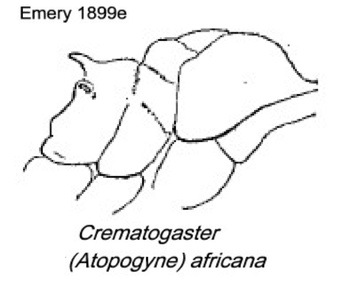 Mayr's
(1895) description is at Mayr's
(1895) description is at  ; with that of schumanni at ; with that of schumanni at  . Emery (1899e) provided
a drawing of the thorax profile of the major (top right) and noted how
it could be distinguished from buchneri by having a prominently
raised spiracle below the propodeal spine; this is at . Emery (1899e) provided
a drawing of the thorax profile of the major (top right) and noted how
it could be distinguished from buchneri by having a prominently
raised spiracle below the propodeal spine; this is at  . Santschi's (1937g) description of the
type queen (plus that of stanleyi) is at . Santschi's (1937g) description of the
type queen (plus that of stanleyi) is at  . Mayr's (1902)
description of variegata is at . Mayr's (1902)
description of variegata is at  . Forel's (1910e)
description of biemarginata is at . Forel's (1910e)
description of biemarginata is at  . Forel's (1911e)
description of alligatrix is at . Forel's (1911e)
description of alligatrix is at  . Forel's (1913h)
description of brieyi is at . Forel's (1913h)
description of brieyi is at  . Santschi's (1915c)
description of stanleyi is at . Santschi's (1915c)
description of stanleyi is at  . Santschi's (1921c)
description of thoracica is at . Santschi's (1921c)
description of thoracica is at  . Wheeler's (1922)
description of tibialis is transcribed below. Santschi's
(1937g) description of stolonis is at . Wheeler's (1922)
description of tibialis is transcribed below. Santschi's
(1937g) description of stolonis is at  . .
|
Analysis of type forms
Note: Given new
status (here)
Crematogaster
(Atopogyne) tibialis
(Crematogaster
(Atopogyne) africana subspecies tibialis new subspecies , Santschi, in
Wheeler, 1922: 157, worker) from Zaïre, collected at Mosekowa
between Walikale and Lubutu, by J. Bequaert
As a junior synonym of Crematogaster (Atopogyne) wasmanni; Crematogaster
Buchneri For. stirps africana
Mayr var. Stanleyi, Santschi,
1915c: 353; Mindouli, by A. Weiss, in Wheeler, 1922: 852,
worker) from Congo
The photographs of polymorphica
Weber (1943c) show that it is a junior synonym of Crematogaster
(Atopogyne) buchneri and not of africana.
|
 Nigeria specimens (Taylor, 1979: 35) - WORKER.
Size
very variable TL 3.23-5.51 mm; largest HL 1.46, HW 1.43, SL 1.00, PW
0.78 Nigeria specimens (Taylor, 1979: 35) - WORKER.
Size
very variable TL 3.23-5.51 mm; largest HL 1.46, HW 1.43, SL 1.00, PW
0.78
Colour generally dark brown-black. Dense pilosity, erect hairs
abundant, postpetiole with 10-12 long hairs. Mandible of largest worker
with a nearly straight masticatory margin. Alitrunk profile convex
interrupted by a low mesonotal carina and a depression to a shallow
metanotal groove. Propodeal spines short, acute and down turned.
Postpetiole with the lower anterior corners rounded.
Santschi (1915c) described variety stanleyi as -
WORKER - TL 2.8-3.8 mm; differs from type by its really black colour;
with the funiculi and tarsi brown; and extreme sides of genae and apex
of mandibles red yellow; length less variable; spines and pedicel as africana.
Specimens from Congo, Mindouli, by A. Weiss, 1907. Santschi
noted that with the type the colour is more brown and the length more
variable.
Sexual forms are shown on Crematogaster
africana
sexuals.
|
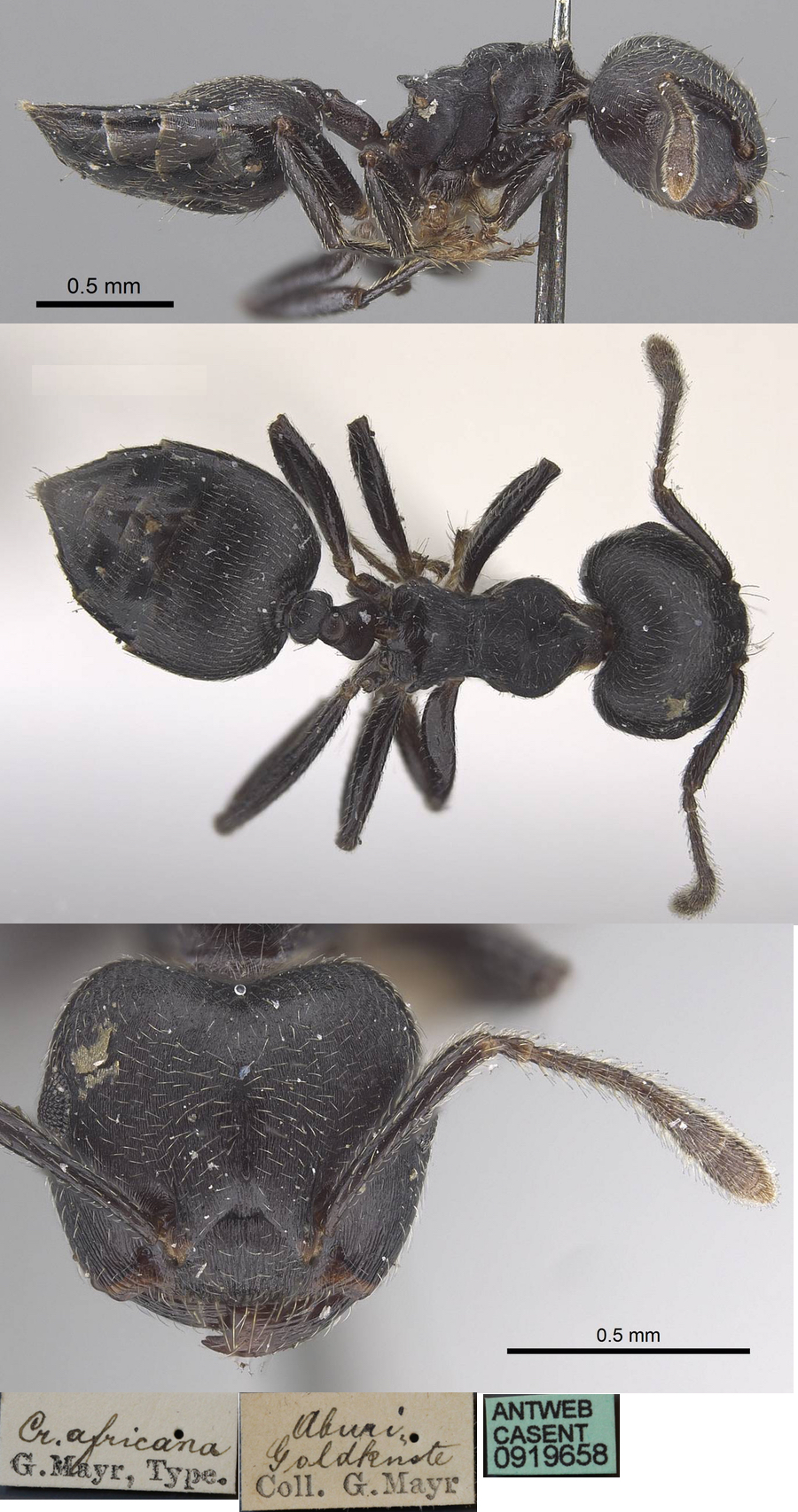 The photomontage of the
type minor worker is
collated from http://www.antweb.org/specimen.do?name=casent0919658 The photomontage of the
type minor worker is
collated from http://www.antweb.org/specimen.do?name=casent0919658
This and the minor worker of Cameroun 97, below, are an
exact match.
|
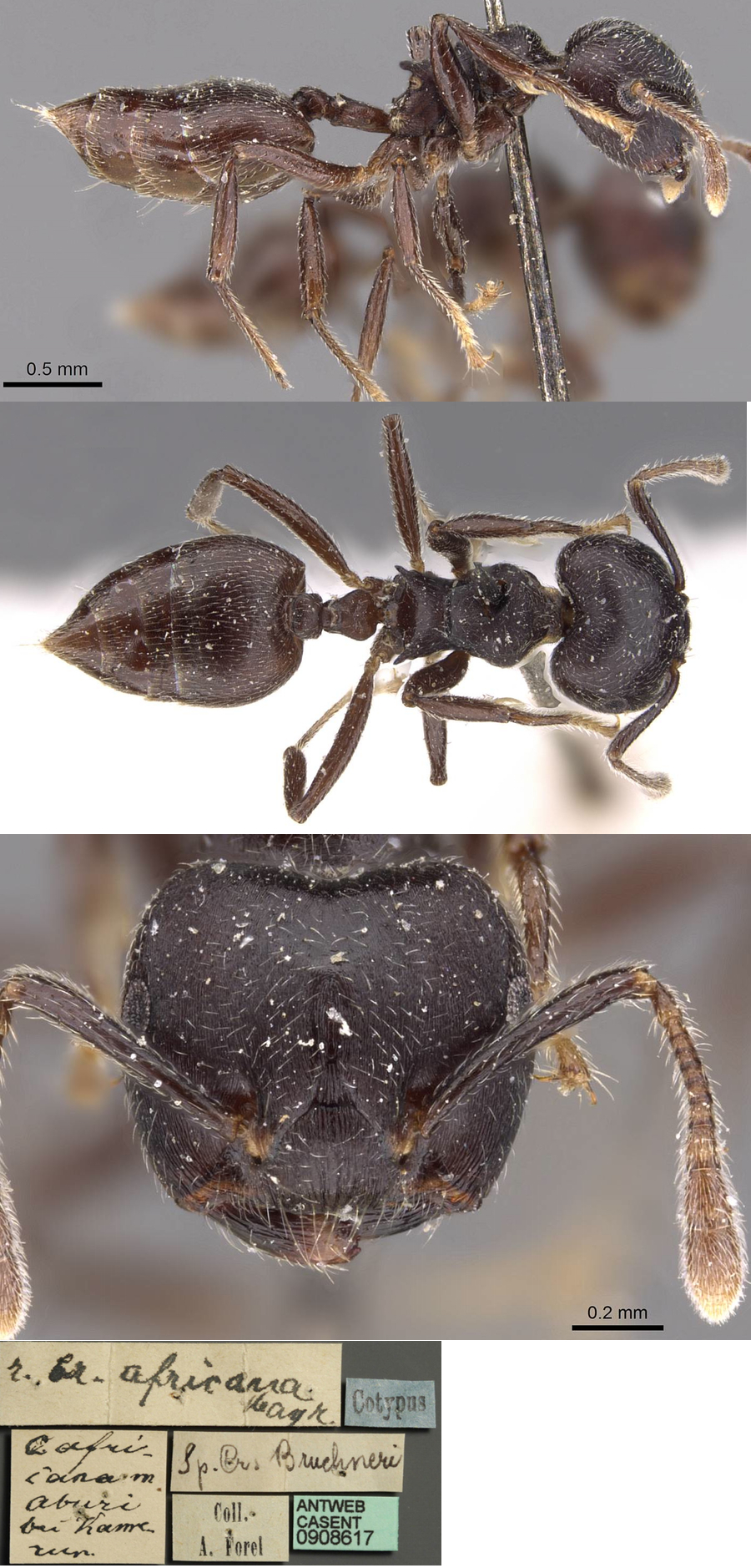 The photomontage of
a cotype minor worker is
collated from http://www.antweb.org/specimen.do?name=casent0908617 The photomontage of
a cotype minor worker is
collated from http://www.antweb.org/specimen.do?name=casent0908617
|
Oxford University
Museum
specimens
|
 Largest worker Largest worker
The photomontages are of workers collected in Cameroun
- south-western tropical coastal forest area between Edéa and Campo
(McKey Wolbachia project, Cameroon 97) . These are typical of africana
as I
encountered and drew in Nigeria.
|
 Smallest worker Smallest worker |
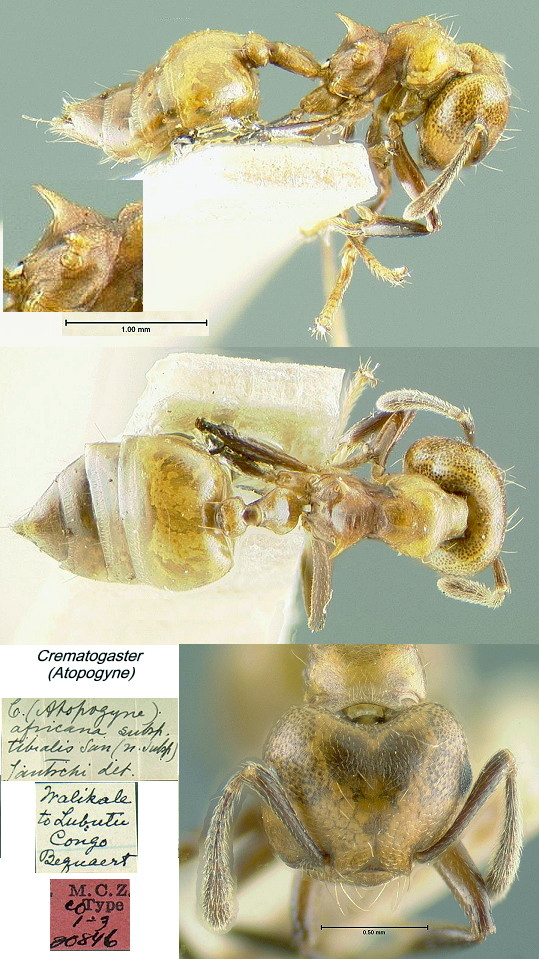 Wheeler (1922) included the following description of tibialis:
The photomontage is collated from http://mcz-28168.oeb.harvard.edu/mcz/FMPro?-DB=Image.fm&-Lay=web&-Format=images.htm&Species_ID=20846&-Find Wheeler (1922) included the following description of tibialis:
The photomontage is collated from http://mcz-28168.oeb.harvard.edu/mcz/FMPro?-DB=Image.fm&-Lay=web&-Format=images.htm&Species_ID=20846&-Find
WORKER - Length 3.5 mm. Pale castaneous. Propodeum, postpetiole, and
posterior half of gaster of a deeper castaneous tint, passing to
reddish brown. A spot on the vertex and the appendages dark. brown, the
tibiae and metatarsi blackish, the tarsi and the'extremity of the
thorax reticulate, the propodeum more finely, with some fine
longitudinal rugae on the whole basal surface. Sides of the mesonotum
regularly reticulate-punctate, Sides of the pronotum more shining and
of the propodeum longitudinally striate. Petiole finely reticulate;
gaster finely shagreened, almost smooth. The pubescence is rather well
developed on the head, the gaster, and the appendages, sparse on the
thorax. The hairs are very sparse, except around the mouth and at the
tip of the gaster. Head square, with rather convex sides and straight
posterior border. Eyes at the middle of the sides. Frontal area short,
feebly impressed behind. Frontal carinae developed. Clypeus slightly
convex, with rather arched anterior border. Mandibles striate-punctate,
with four blackish teeth. The pronotum forms with the basal surface of
the mesonotum a plane surface with a contour like that of C.
castanea Smith. Sides of the basal surface of the mesonotum blunt,
not marginate, with the anterior eminence scarcely indicated.
Promesonotal suture little or not at all impressed. Sides of the
pronotum marginate. Declivity of mesonotum oblique, feebly concave from
right to left, above with marginate sides. Metanotal furrow moderately
deep. Dorsum of propodeum trapezoidal, its length equal to its width
anteriorly in the small worker. It is convex in front, more feebly
behind. The spines are as short as a fifth of the interval between
their bases, which is concave. They are directed backward and slightly
outward. Declivity as long as two-thirds of the basal surface and
forming with it an angle of about 145°. Petiole trapezoidal, as broad
as long, and as broad as the propodeum. Last antennal joint reddish. A
fine and dense striation disposed as in africana (Mayr) but
more or less effaced on the front, vertex and occiput, where the
reflection is more shining than silky, Propodeum transversely
striate-rugose. Petiole smooth, postpetiole and gaster very finely
shagreened, almost shining. The head is, moreover, punctate as in africana
and much less smooth in the individuals with large head. The head,
which varies in size independently of the rest of the body, which is
almost invariable, is sometimes longer than broad and scarcely
emarginate behind, sometimes broader than long, strongly concave behind
and with convex sides. Eyes more posterior than in africana.
Frontal area narrow, strongly impressed and shining. Mandibles
punctate, feebly striate. Metanotal impression stronger than in africana,
the pronotum less marginate anteriorly. Mesonotum carinate, more
elongate and with the declivous surface much less abrupt than in africana,
with longer propodeal spines, even longer than in the variety variegata
(Mayr) and a little farther apart. Petiole and postpetiole as in africana
(notes sent to Wheeler by Santschi).
Numerous workers taken at the village of Mosekowa between Walikale and
Lubutu by Dr. Bequaert from the peculiar pouches of Macaranga
saccifera (Bequaert, 1922, p Part IV) growing in the Rain Forest.
As only adult ants and no brood were found in the pouches, Dr. Bequaert
does not regard them as true nests. The openings of the pouches were
not closed with fibrous carton. Bequaert (p 454) also recorded them
from stipules of an Uragoga species; and from Barteria
deweverei (p 441).
|
Bionomics & distribution notes
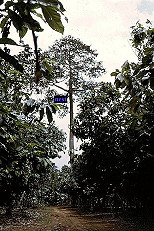 Wheeler (1922) listed various other findings including
the nominate from Ghana (at Aburi, R. Buchholz), Nigeria (Old
Calabar) and Cameroun (Duala, von Rothkirch). Bequaert (1922, p
413) found workers of ssp tibialis inside the nectary
containing leaf stipules of Macaranga saccifera at Mosekowa, Zaïre. Wheeler (1922) listed various other findings including
the nominate from Ghana (at Aburi, R. Buchholz), Nigeria (Old
Calabar) and Cameroun (Duala, von Rothkirch). Bequaert (1922, p
413) found workers of ssp tibialis inside the nectary
containing leaf stipules of Macaranga saccifera at Mosekowa, Zaïre.
Forel (1909b) noted E. André had asked him to identify Crematogaster
from Congo collected by Father Hermann Kohl and Professor Laurent,
botanist, from in the stems of plants. These included this species,
sample No. 21, from Kisangani [Stanleyville] in the hollow twigs of Cuviera
angolensis. Forel (1911f) reported alligatrix (as ssp of buchneri)
from Zaïre, Kasai, Kondué by Luja. Later, Forel (1915c) reported alligatrix
as collected at St. Gabriel, Kisangani, Zaïre, by Kohl, with a carton
nest attached to the trunk of a mango tree. Forel (1916) described camena
as very close to variegata but darker, somewhat larger and
with shorter subdentiform propodeal spines, plus a sharper pronotal
carina and a deeper metanotal groove.
Bernard (1952) listed it as very common in tropical
Africa; Forel and Santschi had created many races and varieties
"without great value". Among the subdivisions from Guinea the
Mt. Nimba surveys had found the typical form - 4 alate queens from
Nion, Mount Tô (1900 m), a male at Yalanzou and several workers from
Yanlé and Zouépo forest; also ssp schumanni (small and shiny)
from Yanlé and Kéoulenta forest leaf litter; and ssp fickendeyi
(medium sized, matt and shagreened) the most widespread form at Zouépo,
Nion, forest at 1000 m, crests, etc.- but see kohli below.
|
 A
relatively common dominant species in Nigeria, building large
carton nests on certain species of large forest trees (e.g. Silk
Cottons, Ceiba pentranda and Bombax costatum)
[clickable thumbnail photo right]. Rarely nests on cocoa. Forages very
widely over trees adjacent to nest tree and will cross the ground
between trees. Can cause some loss of production in cocoa by removing
flowers, the extent of this loss and the reason for the activity is not
known. On CRIN cocoa at Onipe 1/1 it occurred on 12.8% of cocoa trees,
and on 7.7% under forest shade (W20), and in cocoa surveys (where it
was not separated from Cr. depressa) it was found on 10-12% of
trees (Taylor, 1977; Taylor & Adedoyin, 1978). Earlier from CRIN,
perhaps on >10% of cocoa in pkd collections from two cocoa blocks,
W13/2 and W18/1 (Booker 1968). A
relatively common dominant species in Nigeria, building large
carton nests on certain species of large forest trees (e.g. Silk
Cottons, Ceiba pentranda and Bombax costatum)
[clickable thumbnail photo right]. Rarely nests on cocoa. Forages very
widely over trees adjacent to nest tree and will cross the ground
between trees. Can cause some loss of production in cocoa by removing
flowers, the extent of this loss and the reason for the activity is not
known. On CRIN cocoa at Onipe 1/1 it occurred on 12.8% of cocoa trees,
and on 7.7% under forest shade (W20), and in cocoa surveys (where it
was not separated from Cr. depressa) it was found on 10-12% of
trees (Taylor, 1977; Taylor & Adedoyin, 1978). Earlier from CRIN,
perhaps on >10% of cocoa in pkd collections from two cocoa blocks,
W13/2 and W18/1 (Booker 1968).
In Ghana, mentioned by Donisthorpe (1945b) as
collected by H.E. Box (25.xii.1944) from Cola species in
fringing forest in the savannah-forest belt of North Ashanti, 10 km
north of Wenchi. It was listed by Strickland (1948 - as africanum,
1951a, b), who described it as generally not very common, but dominant
in cocoa farms where Canthium trees were present (more than
5/ha), for example at Bunso (where Canthium had been planted
at 10/ha) africana occurred on over 40% of cocoa. Bolton
(1970-71) listed it as one of the six most common Crematogaster
species on cocoa (simply at CRIG or in Ghana is not clear). Leston
(1973) also regarded it as a dominant. Later collected by Room (1971)
from all parts of the Mamfe-Mampong cocoa farm, his report includes
reference to it nesting in cocoa canopy. It also occurred in 32 of his
168 canopy samples at other farms; 30 of those samples, however, were
from trees selected for its presence as a dominant. Room also reported
its occurrence as the commonest of all insects on cocoa mistletoe -
with 62,511 workers from 445 of 630 samples of the mistletoe/cocoa
junction, and 122 of 175 samples of mistletoe plants (Room, 1972a, b,
1975). In the first of those papers, Room described its special
relation with the pseudococcid, Cataenococcus loranthi
(Strickland), the most prevalent of mealybugs on cocoa mistletoe. He
noted, however, that Cr. africana was particularly common in
the study area, the Akwapim Hills, and that other dominants were
relatively scarce there. Bigger (1981a) also referred to its special
relationship with Planococcoides njalensis on Canthium
subcordatum.
It was among the dominant species studied at Nko'emvon
in Cameroun by Jackson (1984), occurring on 25% of the trees
in one cocoa plot and negatively associated with Oecophylla
longinoda and Tetramorium aculeatum. She described it as
preferring dense canopy but did not mention its nest sites. In a study
of terrestrial foragers, she found it in large numbers in two heavily
shaded grid squares (each being 1 of 12 sampling areas in the study
plot).
The photomontage is of a major worker from Ghana,
collected
by S Sky Stephens, 2006.
|
|